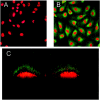Endothelial oxidative stress activates the lectin complement pathway: role of cytokeratin 1
- PMID: 11549596
- PMCID: PMC1850443
- DOI: 10.1016/S0002-9440(10)61779-8
Endothelial oxidative stress activates the lectin complement pathway: role of cytokeratin 1
Abstract
Oxidative stress increases endothelial mannose-binding lectin (MBL) binding and activates the lectin complement pathway (LCP). However, the molecular mechanism of MBL binding to the endothelium after oxidative stress is unknown. Intermediate filaments have been previously reported to activate the classical complement pathway in an antibody-independent manner. We investigated whether oxidative stress increases human umbilical vein endothelial cell (HUVEC) cytokeratin 1 (CK1) expression and activates the LCP via MBL binding to CK1. Reoxygenation (3 hours, 21% O(2)) of hypoxic HUVECs (24 hours, 1% O(2)) significantly increased CK1 mRNA (in situ hybridization) and membrane protein expression [enzyme-linked immunosorbent assay (ELISA)/confocal microscopy]. Incubating human serum (HS) with N-acetyl-D-glucosamine or anti-human MBL monoclonal antibody attenuated MBL and C3 deposition on purified CK1 (ELISA). CK1 and MBL were co-immunoprecipitated from hypoxic HUVECs reoxygenated in HS. Treatment with anti-human cytokeratin Fab fragments attenuated endothelial MBL and C3 deposition after oxidative stress (ELISA/confocal microscopy). We conclude that: 1) endothelial oxidative stress increases CK1 expression, MBL binding, and C3 deposition; 2) inhibition of MBL attenuates purified CK1-induced complement activation; and 3) anti-human cytokeratin Fab fragments attenuate endothelial MBL and C3 deposition after oxidative stress. These results suggest that MBL binding to endothelial cytokeratins may mediate LCP activation after oxidative stress.
Figures







Similar articles
-
A keratin peptide inhibits mannose-binding lectin.J Immunol. 2001 Mar 15;166(6):4148-53. doi: 10.4049/jimmunol.166.6.4148. J Immunol. 2001. PMID: 11238665
-
Ulex europaeus agglutinin II (UEA-II) is a novel, potent inhibitor of complement activation.Protein Sci. 2001 Feb;10(2):277-84. doi: 10.1110/ps.26401. Protein Sci. 2001. PMID: 11266613 Free PMC article.
-
Complement activation after oxidative stress: role of the lectin complement pathway.Am J Pathol. 2000 May;156(5):1549-56. doi: 10.1016/S0002-9440(10)65026-2. Am J Pathol. 2000. PMID: 10793066 Free PMC article.
-
Collectins and collectin receptors in innate immunity.APMIS Suppl. 2000;100:1-59. APMIS Suppl. 2000. PMID: 11021254 Review.
-
[Immunology in the medical practice. XXVII. Mannose-binding lectin, an important link for nonspecific or hereditary immune reaction].Ned Tijdschr Geneeskd. 2000 Jun 17;144(25):1214-9. Ned Tijdschr Geneeskd. 2000. PMID: 10897301 Review. Dutch.
Cited by
-
The mannose-binding lectin: a prototypic pattern recognition molecule.Curr Opin Immunol. 2006 Feb;18(1):16-23. doi: 10.1016/j.coi.2005.11.014. Epub 2005 Dec 20. Curr Opin Immunol. 2006. PMID: 16368230 Free PMC article. Review.
-
Immunofluorescence confocal laser scanning microscopy and immuno-electron microscopic identification of keratins in human materno-foetal interaction zone.J Cell Mol Med. 2009 Apr;13(4):735-48. doi: 10.1111/j.1582-4934.2008.00363.x. Epub 2008 May 7. J Cell Mol Med. 2009. PMID: 18466353 Free PMC article.
-
A TP53-based immune prognostic model for muscle-invasive bladder cancer.Aging (Albany NY). 2020 Dec 15;13(2):1929-1946. doi: 10.18632/aging.202150. Epub 2020 Dec 15. Aging (Albany NY). 2020. PMID: 33323544 Free PMC article.
-
Impact of mannose-binding lectin deficiency on radiocontrast-induced renal dysfunction.Biomed Res Int. 2013;2013:962695. doi: 10.1155/2013/962695. Epub 2013 Dec 10. Biomed Res Int. 2013. PMID: 24386641 Free PMC article. Review.
-
Complement 3 is involved with ventilator-induced lung injury.Int Immunopharmacol. 2011 Dec;11(12):2138-43. doi: 10.1016/j.intimp.2011.09.008. Epub 2011 Oct 5. Int Immunopharmacol. 2011. PMID: 21979496 Free PMC article.
References
-
- Thiel S, Vorup-Jensen T, Stover CM, Schwaeble W, Laursen SB, Poulsen K, Willis AC, Eggleton P, Hansen S, Holmskov U, Reid KB, Jensenius JC: A second serine protease associated with mannan-binding lectin that activates complement. Nature 1997, 386:506-510 - PubMed
-
- Turner MW: The lectin pathway of complement activation. Res Immunol 1996, 147:110-115 - PubMed
-
- Turner MW: Mannose-binding lectin: the pluripotent molecule of the innate immune system. Immunol Today 1996, 17:532-540 - PubMed
-
- Turner MW: Mannose-binding lectin (MBL) in health and disease. Immunobiology 1998, 199:327-339 - PubMed
Publication types
MeSH terms
Substances
Grants and funding
LinkOut - more resources
Full Text Sources
Other Literature Sources
Molecular Biology Databases
Research Materials
Miscellaneous

